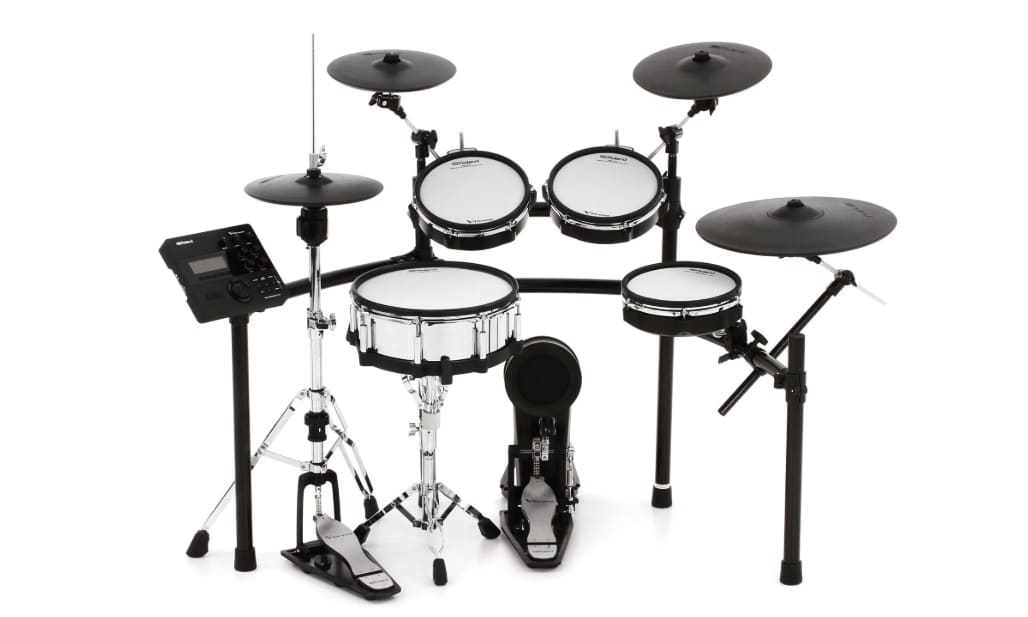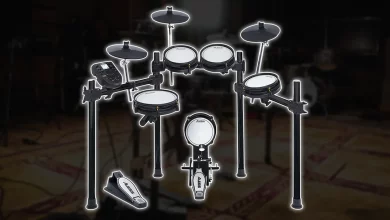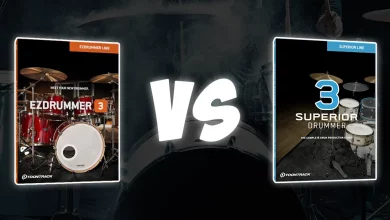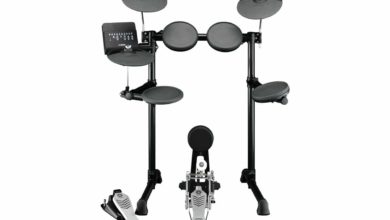
We may earn a commission from the affiliate links on this site. Learn more›
Roland made big waves back in 2020 at NAMM. The first significant drop from the electronic instrument giant in drums and percussion is the Roland TD-27KV.
The TD-27KV is Roland’s latest entry into the V-Drums line featuring an all-new drum module, the TD-27. As is the case with most higher-end e kits, the TD-27KV does not include a snare stand, kick pedal, or hi-hat stand.
Now, before I begin, let me set the record straight. I don’t have any experience with this kit in person. These are my opinions and speculations on the new kit.
Roland V-Drums TD-27KV2
- 2nd generation TD-27 sound module
- Prismatic Sound Modeling
- PureAcoustic Ambience
- Bluetooth MIDI and song streaming
Why pick the Roland V-Drums TD-27KV2?
The TD-27KV2 is perfect for apartment drummers with a little more cash to spend. Music producers in the studio also will benefit from having a high quality electronic kit for recording MIDI performances when using programmed drums.
- High-quality sounds
- Digital snare and ride feel incredible
- Perfect for learning drums on if budget allows
- Pricey
- Rubber kick pad tower
- Drum module has a learning curve
The kit is a five-piece electronic drum set with mesh heads, including four cymbals and the drum module. Right off the bat, I’m super excited about the pad shells.
They’re not full shells like you’d see on the Alesis Strike, but they are an improvement over Roland’s regular PD pads.
Despite being right around $3,000, this V-Drums kit is a mid-level option. Roland targets a higher-end consumer, and the price is generally justified.
Here are some of the features of the TD-27KV:
- Similar sound engine to the TD-50
- Latest digital pads from Roland
- 8-sensor PD-140DS snare drum pad
- 5-sensor CY-18 ride cymbal pad with edge, bow, and bell zones
- Prismatic Sound Modeling
- PureAcoustic Reverb Technology
- MDS-series black rack
- MIDI/Audio over USB capability
- Wireless Bluetooth streaming
The Snare
Arguably the best inclusion on the TD-27KV is the snare pad. It’s 14″ in diameter and feels like the real thing.
The shell itself is reflective steel that looks impressive either on the stage or in the studio.
The PD-140DS snare pad features eight finely-tuned sensors allowing everything from loud rimshots to quiet ghost notes. Natural cross-sticks are also possible with the improved pad.
Buzz rolls sound incredibly realistic for an e kit.
Of course, no electronic drum will ever be able to emulate their acoustic counterparts to an exact degree, but Roland gets as close as possible.
The mesh head itself is three-ply, providing natural rebound and something that feels similar to a real drum.
The TD-27KV snare pad also features tunable tension rods, allowing you to adjust the bounce-factor of the mesh head.
As is with most products from Roland, the drum is extremely robust and of very high-quality.
Don’t forget — a snare stand doesn’t come with the kit.
The Kick Tower
A somewhat disappointing inclusion on the TD-27KV is the kick tower. Of course, there’s nothing wrong with it per se, but I’d hope that at this price range, we might see a full-fledged drum.
I’m splitting hairs, though, since this would only be a cosmetic feature.
The KD-10 kick tower is standard on some of Roland’s e kits, including the TD-17KV. It supports both single and double pedals, so for all you metalheads out there, you’re in the clear.
The feel of the KD-10 is far better than a lot of rubber kick towers. Most cheaper ones feature a hard rubber surface, and thankfully it’s just the opposite here.
The softer material responds much better. The feedback of the playing surface allows for a more dynamic and realistic experience.
The metal frame of the KD-10 is stable and won’t slide forward when used with a rug, though I still recommend some reinforcement.
Just like the snare stand, kick pedals don’t come with the kit.
The Tom Pads
Included with the TD-27KV are three 10″ PDX dual-zone mesh pads. The pads are incredible; however, I wish we would see different sizes for each drum. For example, my Strike kit features 8″, 10″, and 12″ pads.
Two 10″ PDX dual-zone rack toms and a 14″ floor would also have been a great inclusion.
Roland’s PDX pads are a standard for electronic drums, and it seems they’ve gotten a bit of a facelift recently. The plastic shell reminds me more of the snare drum and is a nice improvement visually.
The tom pads are dual-zone, meaning you can assign sounds to both the playing surface and the rim.
Aside from the new look, there’s nothing else to report. The pads are robust, as always.
The Cymbal Pads
Let’s start with the ride cymbal pad. The TD-27KV comes with an 18″ digital ride — a significant improvement when compared to the TD-25KV.
The CY-18DR brings more realism to the e-cymbal world. It features three distinct zones of play: edge, bow, and bell. The ride is chokable (as most e-cymbals these days are), but also allows you to play softly with your finger even.
In addition to the snare, the ride cymbal pad is the next most significant improvement to the mid-level V-Drums series kits.
The other V-Cymbals included are a 12″ CY-12C crash and a 13″ CY13 crash/ride. I love the variation in sizes. I’d much rather have a variety than two of the same pads.
Both the 12″ and 13″ cymbals are dual-zoned with sensors for the bow and edge. It would be nice to see a kit with all three-zoned cymbal pads, but this is a mid-range electronic drum set.
The hi-hat controller included is the VH-10. You’ll notice it’s a single-cymbal design. I kind of wish there was a bottom pad, but the VH-10 performs fine. Again, the hi-hat pad is only dual-zone, allowing for striking the bow and edge.
You will need to pick up a hi-hat stand along with the TD-27KV, as there isn’t one included.
The TD-27 Drum Module
As the name implies, the TD-27KV comes with a new drum module. The TD-27 module is a massive improvement on the TD-25 module, even going as far as including dedicated controls for tuning and muffling.
The module allows for playing in lifelike environments with Roland’s PureAcoustic Ambience Technology. The module emulates different rooms and stages using reverb, but that explanation only scratches the surface of how it works.
One impressive feature I’m excited about is the ability to adjust virtual microphone positions. I like getting hands-on and tweaking, so this is right up my alley.
However, if you’re not, the presets are incredible, so don’t worry about having to learn the module (something I wish Alesis would have taken into account with their Strike module).
Roland’s TD-27 module comes packed with plenty of learning and practice features for those new to playing the drums.
No Audio Interface Required
If you want to record your drum performance, Roland makes it easy, long as you have a computer and some recording software.
The USB connection outputs audio and MIDI. You don’t need an audio interface to record your performance on your computer. You can send up to 28 channels of multitrack audio over USB.
Using virtual instruments with the TD-27 is a breeze — something I highly suggest learning. I find that sounds in varying drum libraries often are far better than sounds included in drum modules.
Stream Audio Over Bluetooth
By far, the most exciting feature of the TD-27 is Bluetooth. I have long yearned for a module that included Bluetooth, and Roland has delivered.
Finding an auxiliary cable to use with a module isn’t hard; it can be annoying sometimes, though. Also, it’s nice that you can leave your phone in your pocket and play along to your favorite playlists.
My Overall Thoughts on the TD-27KV
The Roland TD-27KV is an impressive step-up, and move in the right direction, from the 25KV. It doesn’t have all the features in the world, but it is an excellent mid-level electronic drum set.
There are plenty of other options from smaller boutique companies like Jobecky or ATV that might be better but will require advanced knowledge of the market. I think these kits are a little overkill, in all honesty.
The TD-27KV isn’t the TD-50, but it’s well above the competition in this price range. Compared to the Strike Pro SE, I’d choose the TD-27KV any day of the week.
What are your thoughts on the TD-27KV? I’d love to hear from you down below in the comments. Thanks for reading.





What is the difference between the Roland td 27kv and the td 27kv-s model, also does guitar center carry the td 27kv, when I’m on their website I only see the td 27kv-s.
0
Hi Chris. I’m pretty positive that there is no difference between the KV and KV-S. I believe it’s the same kit.
0
I’m trying to decide between the Strike Pro SE and the td27kv. You mentioned you would pick td27. Comparing them it seems they offer more drums, more sounds, an acoustic design, and much cheaper. I know Roland’s are better builds but Is there anything that went into going for td27 ?
0
Out of the box, I feel the TD27’s samples are far superior to Alesis. Also, the build quality of Roland’s e-drums is better IMO. The hi-hats on Alesis kits are notoriously bad, as was my case with the original Strike kit.
0